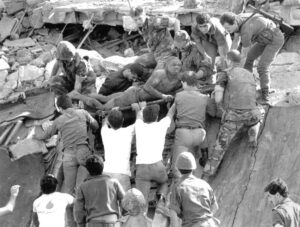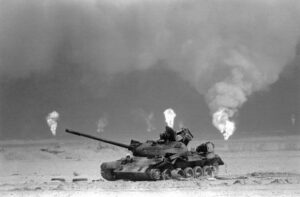(Curator’s Note: Photographs for this story were copyrighted and not available for electronic publishing.)
Overlooked in 20th century war-making is that blatantly corrupt leader of a Balkan backwater who blazed a trail that faltering democratic leaders would follow in reviving domestic political fortunes on foreign battlefields. I speak of Rufus T. Firefly, installed as president of Freedonia on his promise to transfuse the nation’s resources into his personal bank account. “Just wait ‘til I get through with it,’’ Firefly said on taking office. Firefly’s contribution has been overlooked because of the ridicule of his record in the 1933 film, “Duck Soup.’’ Firefly will forever be considered something of a laff riot since the casting of Groucho Marx as the tiny country’s leader. But the film accurately preserves that moment when the blood lust seeps into the veins of a nation ready to launch an attack on enemies real or imagined. It is the Grand Ballroom scene with Groucho, Harpo, Chico and Zeppo, joining the multitude and a heavenly choir in, “We’re Going To War.”
Bottling that emotion-parades, flags, zooming warplanes, roaring tanks, heroes, medals—by political operatives has become an elusive, even dangerous business. But war fever has been a factor in the election campaigns of President Lyndon B. Johnson in 1964; British Prime Minister Margaret Thatcher in 1983; President Ronald Reagan in 1984; President George Bush in 1992 and Russian President Vladimir Putin’s candidacy in 2000. In almost every instance, the use of military power by these leaders involved lopsided conflicts where victory seemed certain over smaller, out-gunned opponents.
There have been plenty of nasty surprises. The Vietnam war would eventually drive Johnson out of the White House. Desert Storm’s triumph over Iraqi President Saddam Hussein faded too soon for Bush. But pulling the sword certainly helped reelect Thatcher and her soulmate, Reagan. And Russia’s campaign in Chechna was instigated, organized and implemented by Putin, whose wartime popularity has driven all potential opponents out of the race for the Russian presidency.
This disturbing trend in democratic politics, where the corpses of hapless opponents are stacked on modern battlefields to the applause of voters, is made possible in part by an increasingly supine media establishment. Thatcher, Reagan, Bush and Putin all succeeded in manipulating newspaper and broadcast journalists so that a vast global audience saw mainly sanitized images of conflicts that effectively masked the face of battle. To do this, the American, British and Russian leaders censored, kidnapped, arrested, pummeled, duped and otherwise obstructed reporters from seeing or reporting the effects of high-tech lethality on low-budget opponents. As a result, the first and often most lasting impression of a military conflict is one specifically designed by image makers in the White House, 10 Downing and the Kremlin. Mostly, these images are of dazzling military hardware. There are no deaths, no losses, no grief, and no mistakes — the real ingredients of warfare. Of all the leaders discussed here, only President Bush, a World War II naval aviator, had first-hand knowledge of the ugliness of war. At one point in his presidency, he talked of a day on an aircraft carrier in the Pacific when a crewmember was sliced in two by a landing aircraft. Bush said he could still hear a chief petty officer calling for a broom to sweep the guts of the flight deck. “I have seen the hideous face of war,” Bush said.
The reality of the battlefield can overwhelm the most ardent voter who initially supported the decision to go to war. After four years of war in South Vietnam and 25,000 American deaths, Johnson began his 1968 reelection bid by assuring voters victory was near. But the Tet offensive that year by North Vietnam attacked U.S. troops in every location, even seizing the U.S. Embassy in Saigon at one point. Of all the unforgettable images from that episode were the still photos by Time photographer Jimmy Olson. It showed an U.S. Marine tank littered with dead and bleeding troops being evacuated with the ancient city of Hue. You could count more than a dozen American bodies. It was after the appearance of the Hue photographs and similar footage by television network cameramen that a chill through the American electorate. Promises of victory were suddenly hollow.
One of the first to notice was Sen. Eugene McCarthy. The Minnesota Democrat had staked his maverick campaign for the Democratic presidential nomination on challenging his party’s incumbent president and the conduct of the war in Vietnam.
“That was the turning point,” said McCarthy of the grisly photographs of the Hue evacuation. Soon, Sen. Robert F. Kennedy joined McCarthy and Johnson announced he would not seek reelection. It was lesson future democratic leaders would not forget. While voters might cheer the launch of a war they would quickly prove fickle when their sons, husbands and fathers began to die. Since Vietnam, masking the face of battle by blinding the media has become a key tactic for leaders when their political fortunes are at stake.
Margaret Thatcher was the first to recognize that a critical press could ruin her opportunity for political revival after an Argentine military junta seized the British Falkland Islands in the spring of 1983. Until the incident 8,000 miles from Britain’s shores, Thatcher was close to being replaced as leader of the Conser-vative Party. Violent labor strikes and an economy in relentless decline had eroded confidence within the Tory ranks. And, the April 1 seizure of the Falklands seemed more fumbling by the Iron Lady who had botched negotiations with the Buenos Aires government over what they called the Malvinas. But Thatcher launched an instant counterattack.
On April 4, Londoners were treated to hastily glued subway signs that recalled Army units to their bases. It instantly recalled World War II when tube stops were routinely used to communicate with a population, which had few telephones. The signs were the subtle beginning of war fever that soon gripped Britain. On April 5, she dispatched a British punitive expedition to the south Atlantic from the historic naval base in Portsmouth. It was a splendid ceremony televised nationwide by the BBC that opened with a shot of HMS Victory, Lord Nelson’s flagship at Trafalgar, in drydock. A cheering crowd had assembled on the dock next to the HMS Invincible, a pocket carrier that launched Harrier vertical take-off fighter-bombers from a ski-jump on the bow. Among the crew was Prince Andrew, following in the footsteps of his grandfather, later King George VI, who was on deck at the World War I battle of Jutland. On Sunday, the day before, longshoremen hand-loaded the ships with food, fuel and ammunition. They produced a human chain that loaded the ship in record time. Weddings were cancelled as young men raced to their posts. The Invincible’s skipper, Captain Jared Black, did not permit the frenzy to interrupt the ship’s tradition of Sunday christenings. “We turn the ship’s bell over and make it a baptismal font‚” Black said. “We christened five babies.” The band was still playing when the Invincible’s basso horn sounded a farewell and ropelines were cast off. “Hip, hip hooray… cheered the crowd. The crew, looking like dark blue icing on an iron gray cake, responded by doffing hats. The ship’s bugle blew and then a bosun’s pipe: 10,000 men on 38 ships were underway to the Falklands. As Invincible pulled away, it revealed HMS Victory with rigging that once flew, “England Expects Every Man To Do His Duty.” Britain, hapless and in decline since 1945, was going to war.
Sailing with the fleet was 17 London journalists. The Thatcher government carefully vetted all. Banned was veteran photographer Don McCullin. Govern-ment officials viewed his work as, “too realistic.” The reporters were permitted to board only after signing a written agreement that all of their dispatches were subject to approval by six accompanying Ministries of Defense officials. Most were galled by the overt imposition of censorship. But there was little choice. Journalists, including Fleet Street reporters, were prevented from traveling to the islands by the Argentine junta. One reporter, Simon Winchester of the London Sunday Times, was arrested and imprisoned for the duration of the conflict for observing air operations at a base near Buenos Aires. To cover the retaking of the Falklands, the choice was stark: Accept censorship or see nothing at all. This control of access became a landmark in manipulating an otherwise aggressive media that usually defied government controls. Since the Falklands, it has become a prized tool of democratic political leaders seeking to manipulate voter perceptions and the key to media control. It took two weeks for the British fleet to reach the Falklands and journey soon raised questions about Thatcher’s decision. While inferior in terms of men, ships and planes, the Argentines had purchased the Exocet, a French-made missile that attacked ships by skimming the surface of the sea at supersonic speed. On May 4, the first Exocet struck the destroyer.
There were no photographs, film or eyewitness accounts from the accompanying press corps. Later, Bernard Ingham, Thatcher’s press spokesman, would blame “improperly aligned” satellites in the south Atlantic for a total blackout of the Argentine attacks on the Sheffield, Antelope and other British warships where 236 sailors and soldiers were killed by blast and fire. While photographs and televised interviews were made public after the conflict, 10 Downing and the Defense Ministry took control of shading these disasters for public consumption when they were first disclosed. For instance, defense officials at a televised press conference said the Sheffield had been, “seriously damaged,” by the attack. That was a bit of an understatement. I had an office in the Guardian building where the editor, Peter Preston, often served as a translator. “That means the Sheffield has been destroyed,” Preston said. He was right. It later sank.
Preston’s reporters were among those ordered to return to ship when the land invasion began. The Guardian was the leading critic of the Thatcher government. Reporters who had accompanied the fleet to the Falklands soon learned that that media friendly to Thatcher gained instant access and front row seats for the campaign. Critics were dubbed unfit for combat coverage. More than 750 Argentines were killed during the Falklands, including 350 sailors sent to the bottom on May 2. The nuclear-powered submarine, HMS Conqueror, torpedoed the Argentine cruiser, Belgrano, and its 1,000-man crew.
Thatcher’s actions that led to sinking the Belgrano, the loss of British life and the seamier side of the Falklands would emerge in bits and pieces months and years after the conflict. But that had little impact on the revitalized image of the Iron Lady who went on to become the longest-serving prime minister in the 20th Century, eclipsing Winston Churchill. On year after the Falklands ended, Thatcher was reelected in a landslide of record proportions. “We have once again restored the dominance of Britain,” Thatcher told the respectful members on June 15. “Never again shall we be the victim of aggression.” No one admired Thatcher’s Falklands campaign more than her American counterpart. For Ronald Reagan and his defense chief, Caspar Weinberger, the Falklands would become the template for manipulating the media in a political crisis. When 241 U.S. Marines were massacred a year later in Lebanon, Reagan appeared to be an aging actor who blundered into a mideastern quagmire. The terrorist bomb that killed the young Americans at a Beirut airport also had shaken Reagan’s reelection hopes.
©2001 Patrick Sloyan
Patrick Sloyan is a senior writer in Newsday’s Washington bureau who is examining the manipulation of the media during military conflicts.


